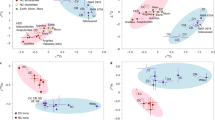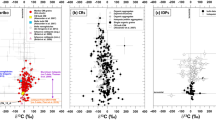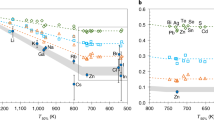Abstract
Materials formed in the early Solar System generally exhibit a characteristic oxygen isotopic signature known as the non-mass-dependent oxygen isotope anomaly1,2, the origins of which are unclear. The anomalies are thought to reflect isotopic fractionation in the chemical reaction that first formed solid material from the gaseous medium, but the proposed mechanism and environment of formation are the subject of debate3,4,5,6. Here we analyse micrometre-sized grains of acid-insoluble organic matter from a carbonaceous chondritic meteorite recovered in Antarctica. We find that the organic matter has the highest 18O/16O and 17O/16O ratios known in planetary material, except for pre-solar grains7. The oxygen ratios are enhanced by up to 53±11% and the 13C/12C values by 29±5% relative to terrestrial values. We suggest that the coherent enrichments of 17O, 18O and 13C in the organic matter can best be explained by its formation being due to the photodissociation of carbon monoxides in a gas medium at temperatures of about 60 K or higher. These conditions are equivalent to those expected at the envelope of the proto-solar nebula, and we suggest the organic matter formed there.
This is a preview of subscription content, access via your institution
Access options
Subscribe to this journal
Receive 12 print issues and online access
$259.00 per year
only $21.58 per issue
Buy this article
- Purchase on Springer Link
- Instant access to full article PDF
Prices may be subject to local taxes which are calculated during checkout




Similar content being viewed by others
Change history
08 February 2011
In the PDF version of this Letter originally published online, the year of publication should have been 2011. This error has now been corrected in all versions of the Letter.
References
Clayton, R. N. Oxygen isotopes in meteorites. Annu. Rev. Earth Planet. Sci. 21, 115–149 (1993).
Clayton, R. N. in Meteorites, Comets and Planets (ed. Davis, A. M.) 129–142 (Treatise on Geochemistry, Vol. 1, Elesevier–Pergamon, 2005).
Thiemens, M. H. Mass-independent isotope effects in planetary atmospheres and the early solar system. Science 283, 341–345 (1999).
Clayton, R. N. Self-shielding in the solar nebula. Nature 415, 860–861 (2002).
Marcus, R. A. Mass-independent isotope effect in the earliest processed solids in the solar system: A possible mechanism. J. Chem. Phys. 121, 8201–8211 (2004).
Lyons, J. R. et al. Timescales for the evolution of oxygen isotope composition in the solar nebula. Geochim. Cosmochim. Acta 73, 4998–5017 (2009).
Nguyen, A. N. et al. Characterization of presolar silicate and oxide grains in primitive carbonaceous chondrites. Astrophys. J. 656, 1223–1240 (2007).
Hashizume, K. & Chaussidon, M. A non-terrestrial 16O-rich isotopic composition for the protosolar nebula. Nature 434, 619–622 (2005).
Hashizume, K. & Chaussidon, M. Two oxygen isotopic components with extra-selenial origins observed among lunar metallic grains—in search for the solar wind component. Geochim. Cosmochim. Acta 73, 3038–3054 (2009).
Yurimoto, H. & Kuramoto, K. Molecular cloud origin for the oxygen isotope heterogeneity in the solar system. Science 305, 1763–1766 (2004).
Alexander, C. M. O’D. et al. The origin of macromolecular organic matter: A carbon and nitrogen isotope study. Meteorit. Planet. Sci. 33, 603–622 (1998).
Pearson, V. K., Sephton, M. A. & Gilmour, I. Molecular and isotopic indicators of alteration in CR chondrites. Meteorit. Planet. Sci. 41, 1291–1303 (2006).
Martins, Z., Alexander, C. M. O’D., Orzechowska, G. E., Fogel, M. L. & Ehrenfreund, P. Indigenous amino acids in primitive CR meteorites. Meteorit. Planet. Sci. 42, 2125–2136 (2007).
Busemann, H. et al. Interstellar chemistry recorded in organic matter from primitive meteorites. Science 312, 727–730 (2006).
Nakamura-Messenger, K., Messenger, S., Keller, L. P., Clemett, S. J. & Zolensky, M. E. Organic globules in the Tagish Lake meteorite: Remnants of the protosolar disk. Science 314, 1439–1442 (2006).
Floss, C. & Stadermann, F. J. High abundances of circumstellar and interstellar C-anomalous phases in the primitive CR3 chondrites QUE99177 and MET00426. Astrophys. J. 697, 1242–1255 (2009).
Remusat, L. et al. Proto-planetary disk chemistry recorded by D-rich organic radicals in carbonaceous chondrites. Astrophys. J. 698, 2087–2092 (2009).
Cody, G. D. & Alexander, C. M. O’D. NMR studies of chemical structural variation of insoluble organic matter from different carbonaceous chondrite groups. Geochim. Cosmochim. Acta 69, 1085–1097 (2005).
Halbout, J., Robert, F. & Javoy, M. Hydrogen and oxygen isotope compositions in kerogen from the Orgueil meteorite—Clues to a solar origin. Geochim. Cosmochim. Acta 54, 1453–1462 (1990).
Young, E. D. & Russell, S. S. Oxygen reservoirs in the early solar nebula inferred from an Allende CAI. Science 282, 452–455 (1998).
Oba, Y. & Naraoka, H. Elemental and isotope behavior of macromolecular organic matter from CM chondrites during hydrous pyrolysis. Meteorit. Planet. Sci. 44, 943–953 (2009).
Aléon, J., Robert, F., Duprat, J. & Derenne, S. Extreme oxygen isotope ratios in the early Solar System. Nature 437, 385–388 (2005).
Visser, R., van Dishoeck, E. F. & Black, J. H. The photodissociation and chemistry of CO isotopologues: Applications to interstellar clouds and circumstellar disks. Astron. Astrophys. 503, 323–343 (2009).
Hashizume, K., Chaussidon, M., Marty, B. & Terada, K. Protosolar carbon isotopic composition: Implications for the origin of meteoritic organics. Astrophys. J. 600, 480–484 (2004).
Aléon, J. & Robert, F. Interstellar chemistry recorded by nitrogen isotopes in Solar System organic matter. Icarus 167, 424–430 (2004).
Rodgers, S. D. & Charnley, S. B. Nitrogen superfractionation in dense cloud cores. Mon. Not. R. Astron. Soc. 385, L48–L52 (2008).
Chakraborty, S., Ahmed, M., Jackson, T. L. & Thiemens, M. H. Experimental test of self-shielding in vacuum ultraviolet photodissociation of CO. Science 321, 1328–1331 (2008).
Sakamoto, N. et al. Remnants of the early solar system water enriched in heavy oxygen isotopes. Science 317, 231–233 (2007).
Ireland, T. R., Holden, P., Norman, M. D. & Clarke, J. Isotopic enhancements of 17O and 18O from solar wind particles in the lunar regolith. Nature 440, 776–778 (2006).
Acknowledgements
The meteorite sample for isotope studies on organic matter was provided to H.N. by the National Institute of Polar Research, Japan. We thank N. Sugiura for comments on the manuscript. K.H. and H.N. were supported in this study by JSPS and the Atmosphere and Ocean Research Institute, University of Tokyo.
Author information
Authors and Affiliations
Contributions
K.H. designed the study; H.N. prepared meteoritic and standard samples; K.H. and N.T. performed the SIMS measurements; K.H. prepared the manuscript; N.T., H.N. and Y.S. gave technical support and conceptual advice.
Corresponding author
Ethics declarations
Competing interests
The authors declare no competing financial interests.
Supplementary information
Supplementary Information
Supplementary Information (PDF 2827 kb)
Supplementary Information
Supplementary Information (XLS 997 kb)
Supplementary Information
Supplementary Information (XLS 967 kb)
Rights and permissions
About this article
Cite this article
Hashizume, K., Takahata, N., Naraoka, H. et al. Extreme oxygen isotope anomaly with a solar origin detected in meteoritic organics. Nature Geosci 4, 165–168 (2011). https://doi.org/10.1038/ngeo1070
Received:
Accepted:
Published:
Issue Date:
DOI: https://doi.org/10.1038/ngeo1070
This article is cited by
-
H, C, and N isotopic compositions of Hayabusa category 3 organic samples
Earth, Planets and Space (2014)



